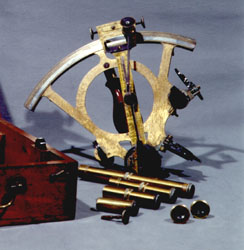 91. Sextant
91. Sextant
Brass sextant for use at sea, with telescope and colored glass filters. There is no indication of the maker. All the parts are, apparently, complete. It has a light-colored wooden handle. The limb is damaged at the graduated scale but is still easily moved.
It is kept in its rectangular wooden box, covered in red velvet. On the inside of the cover is a drawing illustrating the naval flags of the major states and some signal flags used in France, as well as the standards of a few of that country’s provinces, hinting at the likely provenance of the instrument.
The sextant consists of a 60° sector and is used to plot one’s actual position by measuring the angular distance between two stars and their elevation on the horizon. Based on an idea of Newton and Hadley (1682-1744) it was perfected by captain John Campbell (c.1720-1790) in 1758. A system of mirrors allows one to observe simultaneously the two objects one is trying to measure the angular distance, or horizon and an object the elevation of which one intends to compute.
G. L'E. Turner (1991), p. 232.